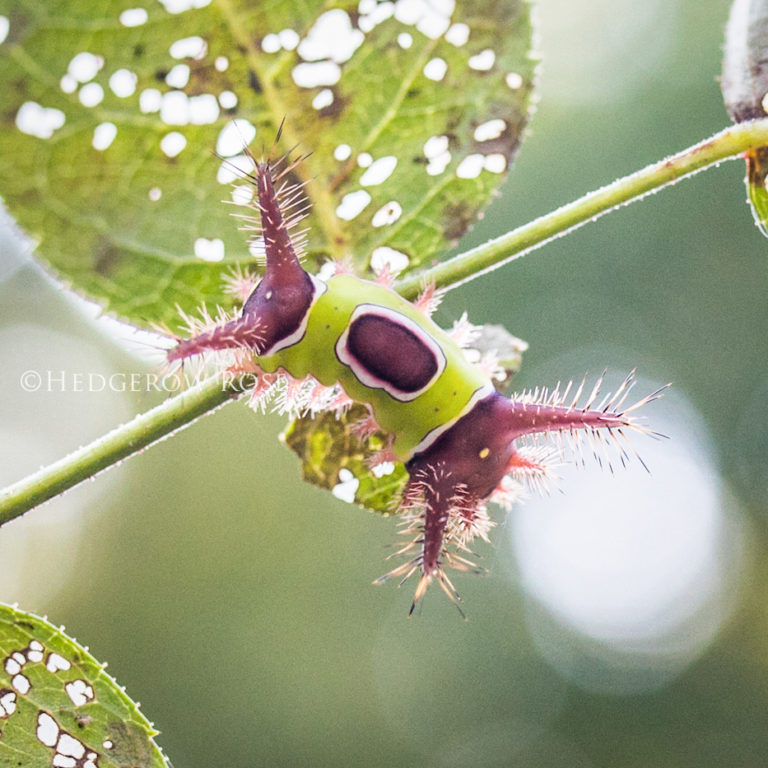Controlling Hydrangea Leaftier

The hydrangea leaftier forms a bladder-like pouch out of the terminal leaves
This year I determined it was finally time to figure out what little critter, exactly, was making what can only be described as leaf pouches out of the terminal leaves on some of our hydrangea shrubs. The infestation was never bad enough to cause alarm; mostly I would remove the leaves and that was that. However, this spring, I seem to have quite a problem at hand, (caused by our dry, warm summer last year?) so it was time to get down to business and take care of this once and for all. The good news is, I think I figured out what is causing the infestation: the hydrangea leaftier, a caterpillar-like larvae which eventually turns into a brown moth. The bad news is, this problem will probably recur year and year, but at least now I know what to do. The hydrangea leaftier forms an “envelope” out of the terminal leaves on a hydrangea shrub and feeds on the flower bud within. As the leaves continue to grow, it takes on the shape of a bladderlike pouch. The larvae eats it’s way through the bud and leaves (causing an unsightly mess) and eventually emerges in June or July as a moth. I try to be as much of an organic gardener as possible and rarely, if ever, spray my plants. So I took care of this problem the old-fashioned way and went out there and squished the heck out of them. (I stopped being squeamish about squishing bugs when I started growing roses.) Another defense is to clip the bud entirely (although you might then lose a flower) and keep the area beneath and around the shrubs clean of debris. Just please don’t put this plant debris in your compost bin. Burn, or throw it out! There is a spray, of course, that can be applied to your shrub before the leaves begin to form but I’ve never tried it, and personally shy away from such things. For me, if a plant is being that persnickety or is that plagued by pests, it just isn’t worth it to keep it around. Maybe someone who has tried that method can offer some tips or advice? Hopefully I literally and figuratively nipped this problem in the bud, because these hydrangeas are so glorious and I look forward to their blooms every summer.
 Opening up the pouch reveals the larvae eating the flower bud within. You do not need to remove the bud from the plant (as I did here for demonstration purposes). Simply carefully open it up, find the larvae, and squish it!
Opening up the pouch reveals the larvae eating the flower bud within. You do not need to remove the bud from the plant (as I did here for demonstration purposes). Simply carefully open it up, find the larvae, and squish it!
 This is what you’re looking for: a pale green caterpillar-like larvae with a brownish head. I found two in the same leaf pouch once, but typically there is only one.
This is what you’re looking for: a pale green caterpillar-like larvae with a brownish head. I found two in the same leaf pouch once, but typically there is only one.
UPDATE: It’s May, 2013 and I just did my annual squishing. I have to say, it just gets better every year. This time around there were hardly any–took me about 5 minutes to find and eliminate the larvae.



Thanks for the answer to this riddle! Keep squishing!
Back at it again this spring, but have only found a few as compared to last year when all 3 shrubs were covered. Hooray!
I use insecticidal soap after removing the pouches…do you think it’s necessary?
Hi Lisa, I never did. Personally, I just found it was easiest to use a no-spray approach by just squishing the larvae and leaving the bud in place (not removing.) That way, there was still a chance for the hydrangea to flower. Good luck to you!
Thank you, here in Ontario, Canada I have the same problem and has been going on for many years, no flowers and didn’t know what to do, I have tried insecticide but they do nothing against the pods. Next year I will definitely try the squeezing of the worm, I would very much like to have flowers again. Thank you NC for your help, much appreciated.
You’re so welcome, Ruth, and I hope you get flowers again!
Hi! Just discovered this problem on my hydrangeas and found you wondering if the flower buds for this season that are affected are still salvageable after I squish the larva?
wondering if the flower buds for this season that are affected are still salvageable after I squish the larva?
Hi Rachel! If you catch them early enough, they should be fine.
So far, it only seems to have infected the Annabelle Hydrangea. The others seem unaffected. But it got into every one of the growing tips. I cut them all off so I suppose I will not get any flowers this year, but hopefully next year will be better. Thanks for reporting on this problem.
Fingers crossed for more blooms next spring!